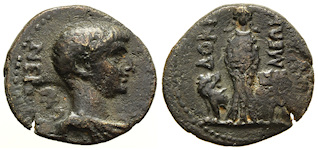Fine Coins Showcase
Antiquities Showcase
Show Empty Categories
Shop Search
Shopping Cart
My FORVM
Contact Us
About Forum
Shopping at Forum
Our Guarantee
Payment Options
Shipping Options & Fees
Privacy & Security
Forum Staff
Selling Your Coins
Identifying Your Coin
FAQs
zoom.asp
Home ▸ Catalog ▸ |Themes & Provenance| ▸ |Gods, Non-Olympian| ▸ |Cybele||View Options:   | | | | | | |


Cybele was born a hermaphrodite, but castrated by the gods, she became female. Heeding the Sibylline oracle the senate brought her worship to Rome in 204 B.C. as the first officially sanctioned Eastern cult. After approval, they were dismayed to learn that the priesthood required voluntary self-castration, which was abhorrent to the Romans. Romans were barred from entering the priesthood or even entering the priest's sanctuary. The eunuch priests, recruited from outside Rome, were confined to their sanctuary, leaving only to parade in the streets during festivals in April. Claudius removed the bans on Roman participation, making worship of Cybele and her consort Attis part of the state religion.RP113887. Brass AE 18, RPC I 3213.3 (same c/m); BMC Phrygia p. 191, 18 (same); Waddington 5954 (same); Hunterian II 2 = SNG Hunt I 2042 (same); c/m: Howgego 224, VF, well-defined countermark, dark patina, open edge crack, weight 3.064 g, maximum diameter 18.1 mm, die axis 0o, Docimeium (Iscehisar, Turkey) mint, c. 55 A.D.(?); obverse NEPΩN KAIΣAP, bare-headed draped bust of young Nero right, countermark: bearded bust left in an oval punch; reverse Cybele standing facing, between two lions, both turned away from her, but looking back in anticipation, ΔOKI/MEΩN divided in two upward lines above lions;
Kallatis, Moesia Inferior, 2nd - 3rd Century A.D.


RP113340. Bronze AE 20, Sutzu I 72; AMNG I/I p. 111, 295; SNG Cop -, SNG Stancomb -; SNG BM -, aVF, near centered, black patina, porous, weight 4.933 g, maximum diameter 19.8 mm, die axis 225o, Kallatis (Mangalia, Romania) mint, 2nd - 3rd century A.D.; obverse KTIC-THC (clockwise from upper right), laureate head of Herakles right; reverse KAΛΛA-TIANΩN (clockwise from upper right), Kybele seated left, turreted and draped, phiale in right hand, left arm resting on tympanon (drum) behind; ex V-auction Rohde (Apr 2007);
Sala, Lydia, c. 98 - 117 A.D.


The town of Sala is identifiable with Tepecik in today's west Asiatic Turkey, but in antiquity was in the Roman province of Lydia in Asia Minor.RP113001. Bronze AE 19, RPC Online III 2438; BMC Lydia p. 228, 11; SNG Cop 422; SNG Leypold II 1178; Waddington 6435; Weber 6895; Lindgren I 797, VF, well centered, green patina, obv. flatly struck, light deposits, weight 5.132 g, maximum diameter 19.4 mm, die axis 30o, Lydia, Sala (Tepecik, Turkey) mint, c. 98 - 117 A.D.; obverse bust of Athena right, wearing crested Corinthian helmet and aegis; reverse CAΛHNΩN, Cybele seated left, kalathos on head, phiale in right hand, resting left arm on tympanum (drum), lion at feet on far side;
Claudius and Agrippina Junior, 50 - 13 October 54 A.D., Smyrna, Ionia


Agrippina Jr. was daughter of Agrippina Sr. and Germanicus, sister of Caligula, and mother of Nero. She seduced and married her uncle Claudius, murdering him after she secured the thrown for Nero. A soothsayer prophesied if Nero became emperor, he would kill his mother, Agrippina replied "Let him kill me, only let him rule!" Nero executed her in 59 A.D.RP70082. Bronze AE 21, Klose XXX; RPC I 2475; SNG Cop 1348; BMC Ionia p. 270, 281; Lindgren I A561A, VF, nice near black dark patina, small areas of light corrosion and encrustation, strike weak upper reverse, weight 5.197 g, maximum diameter 21.0 mm, die axis 0o, Smyrna (Izmir, Turkey) mint, 51 - 13 Oct 54 A.D.; obverse jugate laureate head of Claudius and draped bust of Agrippina Junior right, ΣMYP below; reverse EΠI ΦIΛIΣTOY EIKAΔIOΣ (stephanephoros Philistos and strategos Eikadios), Cybele seated left, patera in right, left arm resting on tympanum on seat beside her, small lion right under seat on exergue line; rare; SOLD
Julia Domna, Augusta 194 - 8 April 217 A.D., Hypaepa, Lydia


Cybele, the Phrygian deification of the Earth Mother, was born a hermaphrodite but castrated by the gods, she became female. Heeding the Sibylline oracle, the senate brought her worship to Rome in 204 B.C. as the first officially sanctioned Eastern cult. After approval, they were dismayed to learn that the priesthood required voluntary self-castration, which was abhorrent to the Romans. Romans were barred from entering the priesthood or even entering the priest's sanctuary. The eunuch priests, recruited from outside Rome, were confined to their sanctuary, leaving only to parade in the streets during festivals in April. Claudius removed the bans on Roman participation, making worship of Cybele and her consort Attis part of the state religion.RS43696. Bronze AE 30, BMC Lydia -, SNG Cop -, SNGvA -, SNG Hunterian -, SNG Munchen, SNG Tüb -, SNG Righetti -, Weber -, gF, weight 13.220 g, maximum diameter 30.1 mm, die axis 180o, Hypaepa (near Günlüce, Turkey) mint, 194 - 8 Apr 217 A.D.; obverse IOV ΔOMNA CEBACTH, draped bust right; reverse [EΠI CTPA ...] Δ OYΠAΠIΩNOC, Cybele seated left, lion at feet, holding phiale, elbow on tympanum, YΠAIΠΗNΩN in exergue; extremely rare; SOLD
CLICK HERE TO SEE MORE FROM THIS CATEGORY - FORVM's PRIOR SALES



Page created in 1.141 seconds.









